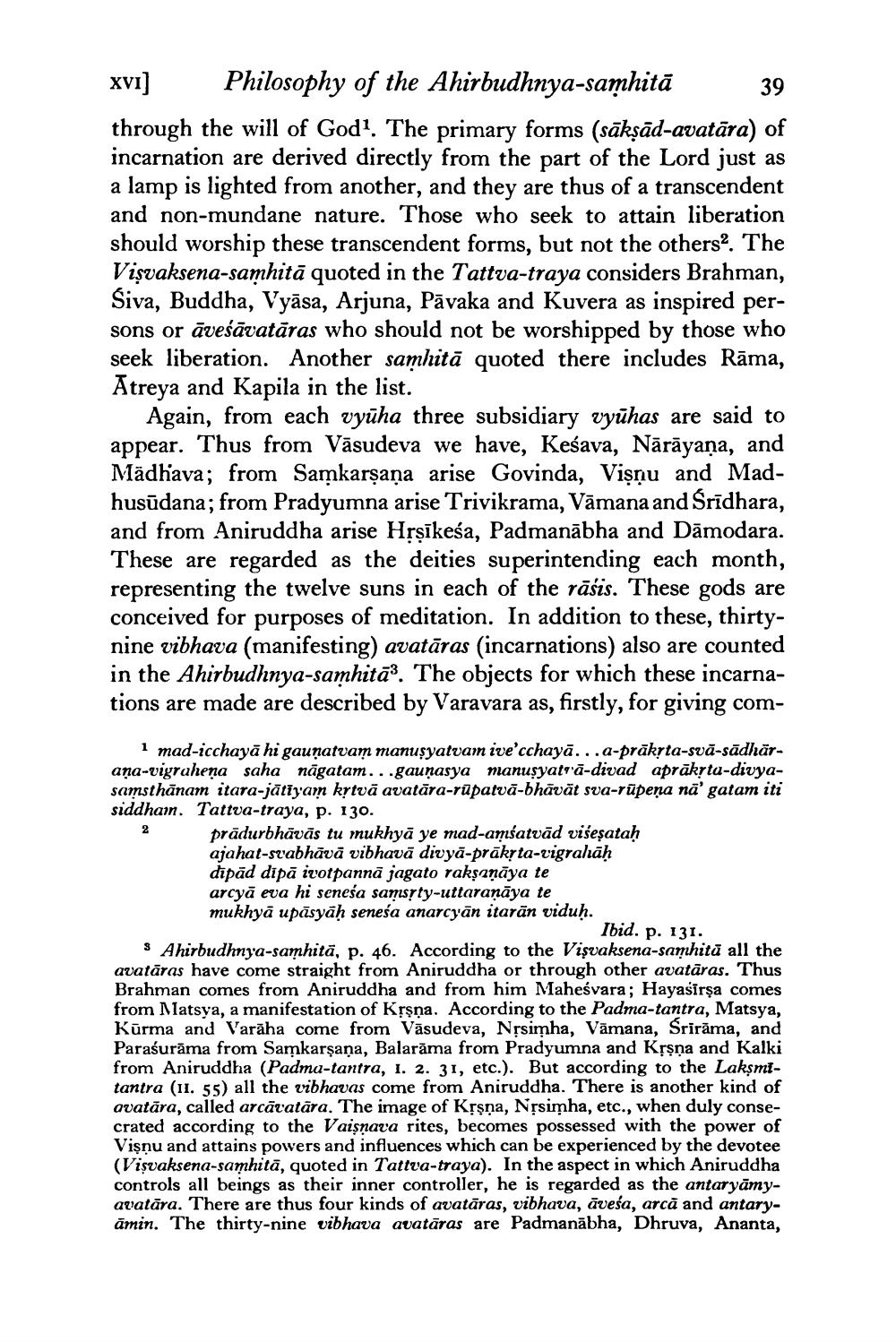________________
XVI]
Philosophy of the Ahirbudhnya-samhitā
39
through the will of God1. The primary forms (sākṣād-avatāra) of incarnation are derived directly from the part of the Lord just as a lamp is lighted from another, and they are thus of a transcendent and non-mundane nature. Those who seek to attain liberation should worship these transcendent forms, but not the others2. The Visvaksena-samhita quoted in the Tattva-traya considers Brahman, Siva, Buddha, Vyāsa, Arjuna, Pāvaka and Kuvera as inspired persons or āveśāvatāras who should not be worshipped by those who seek liberation. Another samhita quoted there includes Rāma, Atreya and Kapila in the list.
Again, from each vyuha three subsidiary vyūhas are said to appear. Thus from Vasudeva we have, Keśava, Nārāyaṇa, and Madhava; from Samkarṣaṇa arise Govinda, Visņu and Madhusudana; from Pradyumna arise Trivikrama, Vāmana and Śrīdhara, and from Aniruddha arise Hṛṣīkeśa, Padmanābha and Damodara. These are regarded as the deities superintending each month, representing the twelve suns in each of the rasis. These gods are conceived for purposes of meditation. In addition to these, thirtynine vibhava (manifesting) avatāras (incarnations) also are counted in the Ahirbudhnya-samhita3. The objects for which these incarnations are made are described by Varavara as, firstly, for giving com
1 mad-icchaya hi gauṇatvam manuṣyatvam ive'cchayā...a-prākṛta-svā-sādhārana-vigrahena saha nagatam...gauņasya manuṣyatra-divad aprakṛta-divyasamsthānam itara-jātīyam kṛtvā avatāra-rūpatvā-bhāvāt sva-rūpeņa nā' gatam iti siddham. Tattva-traya, p. 130.
2
prādurbhāvās tu mukhya ye mad-amśatvad višeṣataḥ ajahat-svabhāvā vibhavā divya-prākṛta-vigrahāḥ dipäd dipa ivotpannā jagato rakṣaṇāya te
arcya eva hi seneśa samsṛty-uttaraṇāya te mukhya upasyaḥ seneśa anarcyan itaran viduḥ.
Ibid. p. 131.
$ Ahirbudhnya-samhitā, p. 46. According to the Visvaksena-samhita all the avatāras have come straight from Aniruddha or through other avataras. Thus Brahman comes from Aniruddha and from him Maheśvara; Hayasirṣa comes from Matsya, a manifestation of Kṛṣṇa. According to the Padma-tantra, Matsya, Kurma and Varaha come from Vasudeva, Nṛsimha, Vamana, Śrīrāma, and Parasurama from Samkarṣaṇa, Balarama from Pradyumna and Kṛṣṇa and Kalki from Aniruddha (Padma-tantra, 1. 2. 31, etc.). But according to the Lakṣmitantra (11. 55) all the vibhavas come from Aniruddha. There is another kind of avatāra, called arcāvatāra. The image of Kṛṣṇa, Nrsimha, etc., when duly consecrated according to the Vaisnava rites, becomes possessed with the power of Visnu and attains powers and influences which can be experienced by the devotee (Visvaksena-samhita, quoted in Tattva-traya). In the aspect in which Aniruddha controls all beings as their inner controller, he is regarded as the antaryamyavatara. There are thus four kinds of avatāras, vibhava, avesa, arcă and antaryamin. The thirty-nine vibhava avatāras are Padmanabha, Dhruva, Ananta,




